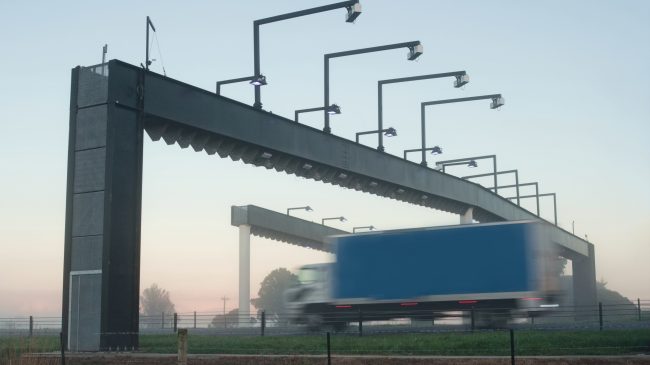In mid-April, German Transport Minister Andreas Scheuer announced that revenues from truck tolling are projected to increase from about €4.8 billion per year to €7.2 billion a year. The increase is due to the expansion of German truck tolling, as of 2018, from only the autobahns to all 40,000 kilometers (km) of federal roads.
Since civil engineers know that heavy trucks account for the lion’s share of pavement damage, we here in the United States periodically hear calls for starting the transition from per-gallon fuel taxes to per-mile charges with mileage-based tolls for trucks. Unfortunately, this is currently outside the realm of U.S. political feasibility. The U.S. trucking industry has long been opposed to any and all expansion of tolling and views mileage-based user fees (MBUFs) as just another form of tolling.
The story is quite different in Europe. Although toll roads are common in France, Italy, Portugal, and Spain, truck tolls are charged in 28 European countries. Yet there has been little resistance from the trucking industry there. There are several reasons for this. First, since fuel taxes in Europe are general governmental revenue (unlike here), the need to account for trucks’ wear and tear on highways has led to political support for charging truck tolls. Second, a large fraction of all European trucking is cross-border, so each national government has an incentive to make sure that all the trucks using its highways are paying for that use. Third, since trucks carry nearly all freight in Europe (whose railways are optimized for passenger service, not freight), truck emissions are seen as a large problem, and truck tolls are justified in part as payment for emissions.
Things are very different in the United States. Trucks here pay federal and state fuel taxes, which are largely devoted to paying for the highways they travel on. Second, virtually all U.S. trucking is domestic, so the need to ensure that non-U.S. trucks pay their way does not apply. And since trucks in America compete fiercely with railroads, the trucking industry has strong incentives to keep its operating costs low—hence their long-standing opposition to expanded tolling.
In addition, U.S. trucking has had bad experiences with tolling. Some of the largest toll agencies divert large fractions of their toll revenues to non-highway purposes; examples include the New York Thruway Authority (directing funding to the state canal system), the Pennsylvania Turnpike (urban transit), the Port Authority of New York & New Jersey (money-losing ports and “economic development” projects), and New York’s Metropolitan Transportation Authority (MTA) Bridges & Tunnels (New York’s transit system). The portion of the toll revenue thus diverted from being used for the toll roads’ capital and operating costs amounts to a tax on toll-payers and is highly resented.
There have also been examples of states singling out trucks to pay for major reconstruction of highways. A case in point is the long struggle for a P3 concession in Virginia in the early 2000s that would have rebuilt the full 325 miles of I-81 in that state, adding dedicated truck lanes—but with only trucks paying the tolls. Two Virginia state senators recently proposed reviving that idea (which will go nowhere).
A far better approach is something I’ve called “truck-friendly tolling.” The basic premise is that the trucking industry depends critically on the Interstate highway system, which has massive needs for reconstruction and for widening dozens of truck-intensive corridors. The American Trucking Associations’ incessant calls for a major increase in the federal diesel tax to address this need continue to fail. But to convince the industry that the best (or least-bad) way forward is toll financing and public-private partnership (P3) delivery requires a much-improved version of tolling.
The most important provision is that the new tolls would be dedicated—by law—solely to the capital and operating costs of the rebuilt and modernized Interstates. This should be included in the federal statute that removes the long-standing federal ban on Interstate tolls, as well as in state enabling legislation to permit a state to make use of this new freedom. Since all vehicles using the rebuilt Interstates would benefit, all would pay the new tolls, not just trucks.
The value for trucking could be improved by adding several other provisions. My suggested list includes the following:
- No “double taxation” as occurs today on tolled highways, where customers pay both fuel taxes and tolls; instead, the electronic tolling system would calculate the amount of fuel consumed on the tolled facility to calculate a rebate of the fuel taxes incurred for those miles.
- Dedicated truck-only lanes in corridors identified in FHWA Freight Analysis Framework projections as being truck-intensive. On these barrier-separated lanes, trucking companies could operate more-productive longer combination vehicles (LCVs), which are currently banned in most states on safety grounds.
- Safe overnight parking areas—a major unmet need for today’s trucking industry.
- Convenient refueling/recharging services for the coming generation of non-diesel trucks.
Ironically, the last two of these points conflict with the position of NATSO, the National Association of Truck Stop Operators, which lobbies fiercely to retain the current federal ban on “commercial” rest areas on Interstate highways. That prevents truck stops from locating on Interstates, where they are most needed, so as to protect current truck stop and fuel/food/beverage operators that are located near Interstate on-ramps and off-ramps.
Instead of engaging in a long, drawn-out battle with the trucking industry over tolling, the truck-friendly tolling approach calls for creating a genuine value proposition for the industry, providing them with a 21st-century version of the aging Interstate system on which so much of their business depends. It’s a uniquely American approach because our trucking industry is so different from that of Europe.
This column first appeared in Public Works Financing.

